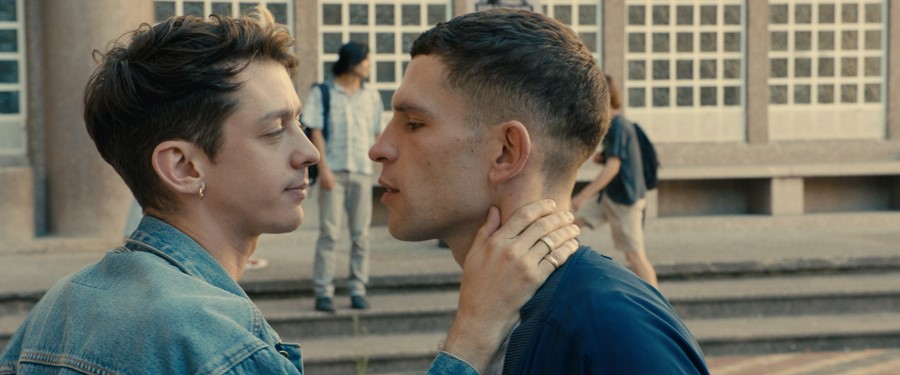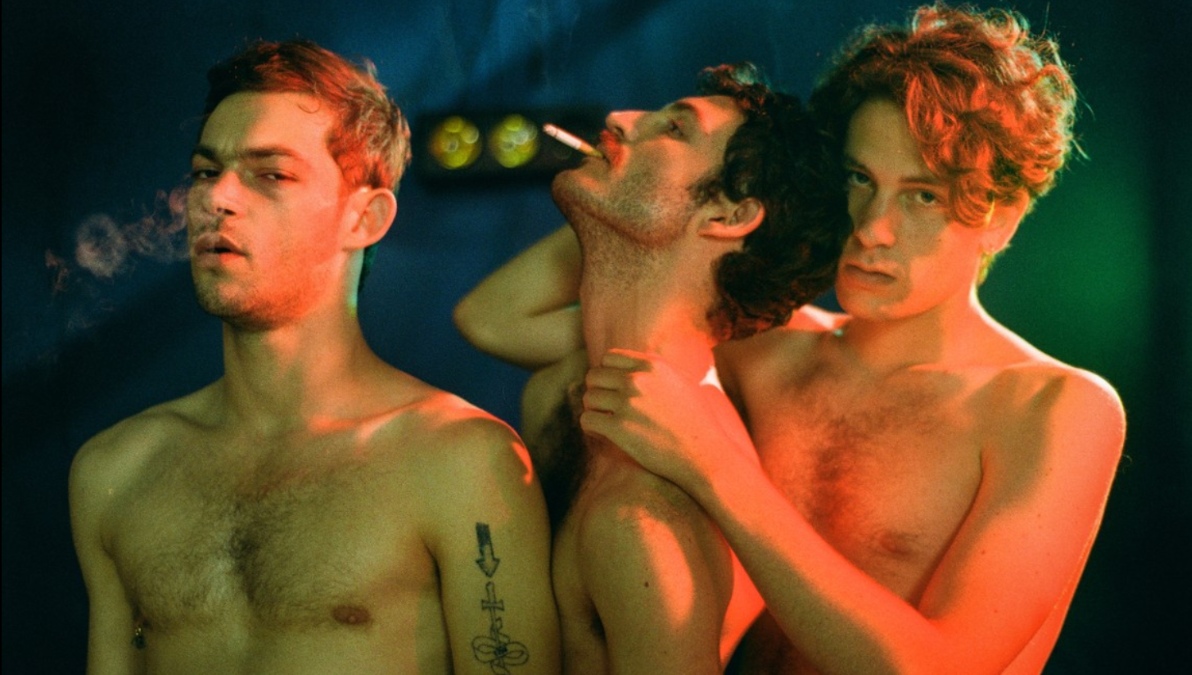In the last couple of years, many of the most impactful queer films to have been made have originated in Paris. First came 120 BPM in 2017. Directed by Robin Campillo who wrote the screenplay based on his experiences in ACT UP in Paris in the 90s, the film follows a group of activists as they wage dramatic, fake blood-soaked war against the government, pharma companies and their sluggish response to the AIDS crisis. The landscape of the film is one of stark blacks and blinding whites, pinging between the morbidity of the AIDS battle in apathetic government buildings, and the joyous intensity of new love on the dancefloor. It ties its manifesto to the burgeoning romance between HIV-negative Nathan and HIV-positive Sean.
Soon after 120 BPM came Sorry, Angel, another film set in early 90s Paris and centred around two men in love, one of whom is growing seriously ill with AIDS. The script strays into the political only tangentially, hinting at AIDS history and the politics of euthanasia — but this work is much more personal, consumed with the turmoils of two individuals as they alternately grasp at and run from love and life itself.
Later in 2018, we saw the more thematically, erm, distinct, gay porn murder mystery Knife + Heart. Furnished with switchblade dildo props and lit up by the flashing neon of the Parisian club scene, Knife + Heart explores the proximity between love and death through kamikaze queer relations. This time the protagonists are female porn directors, and their instinct for self-destruction rivals only that of their obsessively sex-seeking gay male pornstars.

Then there’s Sauvage, which stars Felix Maritaud as a gay sex worker who desperately pursues affection above all else, and is perplexed as to why others don’t kiss their clients. But is this preponderance of queer film-making in Paris symptomatic of a cinematic revolution? Do these films constitute a new wave, or are they merely a renewal of traditional themes and perspectives?
The depressing trope of the unhappy queer ending has marked LGBT cinema for a long time — whether through illness, a serial killer, or extreme pursuit of pleasure, these films seem to perpetuate the idea that being gay and in love primes you for an early grave. This, taken alongside the all-white, mostly male protagonists, leaves one asking; is there anything different at all about this new wave of Parisian queer cinema?
Nick Rees-Roberts literally wrote the book on French queer cinema (he called it French Queer Cinema) in the 2000s. “I concluded that book by criticising the relative timidity on the part of many French gay filmmakers of the period”, he tells i-D. “François Ozon, André Téchiné, Christophe Honoré and others failed to engage with broader social questions of race, ethnicity, and class”.

Rees-Roberts argued that when you look at the edgier, postmodern New Queer Cinema that emerged in the US and elsewhere in the early 90s, Paris was falling behind. Especially as Paris is unofficially its birthplace — the films of Jean Cocteau and Jean Genet in the first half of the 20th century were queer long before the label was existed. But Rees-Roberts points out that there’s always been a “critical resistance to the notion of a queer cinema in France”, because of “an historic aversion to identity politics”. As a result, ostensibly queer cinema has often been subsumed as avant-garde, underground, and auteur.
However, he believes that, since the start of the 2010s, LGBTQ+ cinema in France, has felt revitalised. New Queer Cinema focused on fringe identities and the most marginalised in society, from the underground ballroom scene of Paris Is Burning to the political anger about the AIDS crisis. We can see many of these themes in recent Parisian films: the sex workers and pornstars of Sauvage and Knife + Heart, the activism around the AIDS crisis in 120 BPM. However, alongside the innovations of New Queer Cinema, we can still see the sticking points of the unqualified queer cinema of the 80s which preceded it: the monopolistic focus on white male desire and sex in Sauvage, Sorry, Angel, and 120 BPM. Even the lesbian romance of Knife + Heart is suffocated on all sides by gay men.
The director of 120 BPM admitted to VICE that he went out of his way to include PoC in his film, despite the historic reality that ACT UP in the 90s was “very white”. Still, the main protagonists of 120 BPM are white, as are all the protagonists of the other films. It’s obvious that the perspectives of people of colour are still being excluded. “Due to the larger metro-centric nature of the French cultural economy — the film industry is predominantly Paris-based — the range of queer representations is often metro-normative and mostly includes narratives about younger white men”, Rees-Roberts explains. “The question of trans representation is often sidelined, as is gay female representation. While appearing in films like 120 BPM, for example, trans and lesbian characters remain relatively peripheral. LGBTQs of colour are still few and far between”.

However, there are some quantifiable ways that this wave of recent films distinguish themselves from past eras. For a long time, queer cinema in France was been more concerned with individual authorship than with collectivism. “120 BPM conveys the emotional investment of the group of gay and lesbian activists (the emergence of trans activism came later in France through the 2000s) in social change. In terms of queer visibility, 120 BPM is one of the most important French films of this decade, and this more recent politically-committed way of depicting LGBTQ identities on screen supersedes the earlier maudlin AIDS representation, like Cyril Collard’s Savage Nights, for example.”
While still struggling with some traditional biases and the exclusion of certain narratives, especially those of colour, it’s clear that French queer cinema is moving in radical new directions. It’s not unlike the problems international queer cinema is having, since for all of its glorious steps forward with films like Moonlight, it is still centred largely around the figure of the white male: see Love, Simon, Boy Erased, God’s Own Country and Call Me by Your Name. Alex E. Jung wrote for Vulture that US queer cinema currently is dominated by post-marriage equality assimilationism.
At the very least, and while race is often still neglected, class is coming to prominence. “Age difference and social hierarchy are recurrent themes in recent films. Campillo’s Eastern Boys (made before 120 BPM) tackled the intersection of class, ethnicity, and age through the relationship between a young Ukrainian sex worker and his wealthier, older French client. Alain Guiraudie’s film Stranger by the Lake brought him international recognition for problematising queer sexuality in relation to location, milieu, class, and age. In his last film Staying Vertical he pushed the standard age gap narrative in a much less conventional direction by showing a graphic sex scene between a bi middle-aged writer and a much older man as a form of voluntary euthanasia. This subversive exploration of forms of queer intimacy is far from the more accommodated mainstream global indie films like the aforementioned Call Me by Your Name, for example, in which the camera discreetly pans out of the bedroom window at a strategic moment. Hopefully in the coming years, we’ll see an increasingly diverse cast of characters doing strange things with peaches, without any panning away.

